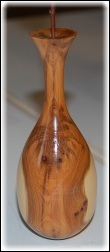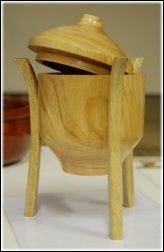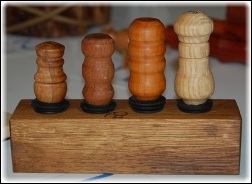Club Night Report
Wednesday 12th June 2013An evening with Ian Hooker, Richard Branscombe and Mike Crawshaw - observations by Vernon Hughes
In the absence of the scheduled presenter for the evening, two Club Members had volunteered to share with the rest of us their specialised knowledge and practice on two subjects of interest to keen woodturners.
The evening began with a brief presentation by Ian Hooker.
Ian explained that it would be advisable to speed up our spheremaking to ensure project completion; before he moves out of the area.
So this is a serious call to action folks (including me). Let's pitch in with balls from all directions and perhaps include some extras for good measure! As a reminder - Ian is looking for hollow (to keep the weight down) spheres at 2" and 3.5" diameter - preferably decorated. Ian lifted a corner of the veil of mystery surrounding his project by explaining that we are contributing to a trop
 hy.
hy.He then issued another call to action. He needs volunteers to help construct the trophy stand and associated base to hold the spheres. Will those able to help please contact Ian for design details, guidance, etc. as soon as possible. He rounded off with an explanation of a method of decorating spheres with a Celtic Knot motif utilising a simple segmenting technique. If you were there you will know what to attempt. If not, but you want to give it a try, ask someone who was there and is sure of the technique.
Richard Branscombe and Chairman Mike Crawshaw then proceeded to fill the evening with presentations on their specialist subjects, Richard before the break and Mike afterwards.
Richard's theme can be described broadly as 'workholding in the lathe' whilst Mike's was 'making your own tools'.
Both displayed masterly expertise.
Richard, who started as a dockyard apprentice at Portsmouth in 1951, demonstrated with
a large range of precisely made components of his own construction that there is no
workholding challenge that cannot be
 met by the exercise of imagination, plus in his case significant technical skill and precision. He started with examples of holding and driving work via 2 and 4 prong centres, ring and Steb centres - and revolving centres. Moving on to faceplate turning, including make your own wooden faceplates, screw chucks, pin chucks, paper and hot-melt glue joints and 4-jaw self-centring chucks along with a myriad of chuck jaws. Next up were collet chucks and home-made varieties of the same. There was a section on jam chucks, friction drives, cole jaws and temporary jigs. Finally, a couple of home-made lathe steadies were shown. For the novice turner - a real education and revelation; whilst for the more experienced - a reminder of what can be done.
met by the exercise of imagination, plus in his case significant technical skill and precision. He started with examples of holding and driving work via 2 and 4 prong centres, ring and Steb centres - and revolving centres. Moving on to faceplate turning, including make your own wooden faceplates, screw chucks, pin chucks, paper and hot-melt glue joints and 4-jaw self-centring chucks along with a myriad of chuck jaws. Next up were collet chucks and home-made varieties of the same. There was a section on jam chucks, friction drives, cole jaws and temporary jigs. Finally, a couple of home-made lathe steadies were shown. For the novice turner - a real education and revelation; whilst for the more experienced - a reminder of what can be done.Click HERE to download a PDF version of Richard's extensive 'crib notes' used in his presentation. This also contains several links to the bearings, wood inserts and rubber bungs used on some of his jigs/ fixtures.
 |
 |
 |


Mike spoke from, and demonstrated, deep personal expertise in metallurgy, focussing for our purposes on steel, including its composition at molecular (or? was it atomic) level. The properties of mild steels (both black and bright), medium carbon and high carbon steels, along with high speed steel plus the latest cryogenic M42 steels and carbides were discussed. Heat treatment of steels to include normalising, annealing, hardening, quenching and tempering were all explained. Mike went on to demonstrate some of the properties of Silver Steel by hardening, quenching and then tempering a bar of the material with gas torch setup and portable hearth.
Both 'stand-ins' are to be congratulated on the thoroughness of their preparations and delivery! It will not be sensible to attempt a detailed account of all that they had to say and show due to the mass of detail involved. Picking out one highlight from each though I found particular personal value in Richard's lathe steadies, and he had come armed with working drawings for them and advice for the likes of me. From Mike we learned that Silver Steel is the material we should use for making our own tools, and that it should be hardened before shaping (not vice-versa). There are sound metallurgical reasons for this.
From this example of how to survive a programmed presenter's inability to show up we can count ourselves lucky that the Club has expertise within the membership as deep as that presented. Hearty thanks to both Richard and Mike!
<Top of Page>
The Show 'n' Tell Theme for the evening was "A Spindle Turned Item" - here is a selection of the items displayed:
 |

|
 |
||
 |
 |
 |
||
 |
 |
 |
||
 |
 |
 |
||
| This month's winning entry in Yew from Harry Rock |
<Top of Page>
